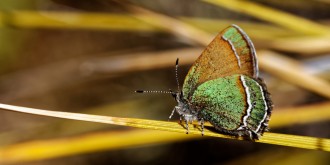The Young Scientist
The Young Scientist
August 19, 2024By Aileen O’Catherine

New Mexico is home to many species of birds and insects. Some of the most popular insects are butterflies, which flutter about in search of nectar and help to pollinate more than 80% of land plants. There is a lot of science behind a butterfly, from its humble beginnings as an egg to its larval stage and eventual metamorphosis into its adult form as a butterfly. New Mexico has many kinds of butterflies, about 300 in total, which can be largely seen through spring and summer.
Scientists place butterflies into the phylum arthropods. A phylum is one of the larger divisions of the animal kingdom. Arthropods are invertebrate animals with an exoskeleton (outer skeleton) and jointed legs. Insects such as butterflies have an exoskeleton, three body sections (head, thorax and abdomen), compound eyes, one pair of antenna and two pairs of wings. Butterflies undergo growth through a process called complete metamorphosis, hatching from an egg into a larva that does not resemble its adult form. The larval body, called a caterpillar, eats and eats until it transforms within a hard shell, called a pupa or chrysalis. Caterpillars hang themselves upside down from a branch or leaf and begin their transformation into the pupal stage. Inside the pupa, growth takes place until the insect becomes an embryo that looks much like its adult self. When the embryo breaks out of its shell, liquid pumps through its body into its wings, inflating them until it looks like an adult butterfly. Scientists classify butterflies into the order called Lepidoptera, which includes butterflies, moths and skippers.
Butterflies have an average life span of about three to four weeks. They are found around the world, from the Arctic to the tropics. The only place they can’t be found is Antarctica because of its sub-zero climate.
Since 2003, New Mexico’s state-designated butterfly has been the Sandia hairstreak (scientific name, Callophrys mcfarlandi), found in 24 of the state’s 33 counties. The Sandia hairstreak is golden green on the underside of its wings, and its caterpillars are widely colored in pinks, greens and maroons. Their larval, or caterpillar, food is beargrass, which can be found on dry hillsides.
Butterflies and caterpillars are important in a number of ways. They are an important food source for many creatures, including birds. Butterflies also are pollinators, drinking all their nutrients from nectar found in flowers and plants. They eat plants when they are caterpillars, but only drink nectar as butterflies. The food they eat as caterpillars is stored in their bodies to help them later in life as a butterfly. Butterflies have an incredibly long tongue, called a proboscis, that acts like a straw to draw nectar from flowers. Butterflies may not chew food, but they can taste — through their feet. Although most of a butterfly’s taste receptors are in its feet, it also has some in its antennae and proboscis. They use their taste receptors to probe plants and decide which are healthy for laying eggs.
All over the world, butterfly populations are in decline. Loss of natural habitat results in fewer butterflies. The healthier the ecosystem, the more native plant populations, the more butterflies you’ll find. A great way to help butterflies is to plant gardens with native plants and flowers. The well-known and loved monarch butterfly, with its striking orange and black wings, feeds on milkweed flowers. Milkweed is easy to grow and attracts not only monarch butterflies, but also the great spangled fritillary (Speyeria cybele), an orange and black New Mexico butterfly found in the northwestern part of the state. Butterflies in New Mexico also like plants such as penstemons, lanceleaf coreopsis, hyssop, white and purple clover, coneflower, verbena, globemallow and blue sage. Planting colorful flowers such as these not only brightens the landscape, but also helps butterflies find the nectar they need. The more butterflies there are, the healthier the ecosystem is. Butterflies are beautiful to look at, but they are also an important part of life on our planet.





